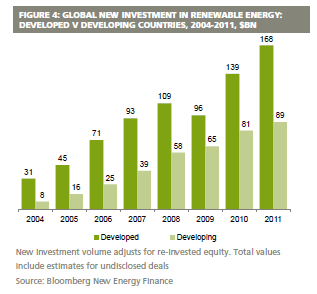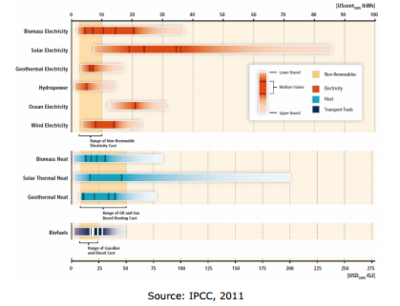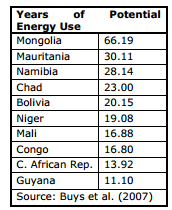Click here to register!
Difference between revisions of "The Economics of Renewable Energy"
***** (***** | *****) |
***** (***** | *****) m |
||
| Line 41: | Line 41: | ||
<br/> | <br/> | ||
| − | |||
= Rationale for <span data-scayt_word="renewables" data-scaytid="4">Renewables</span><br/> = | = Rationale for <span data-scayt_word="renewables" data-scaytid="4">Renewables</span><br/> = | ||
| Line 82: | Line 81: | ||
<br/> | <br/> | ||
| + | <br/> | ||
= <span style="font-size: 19px; line-height: 23px">Costs of Renewable Energy</span> = | = <span style="font-size: 19px; line-height: 23px">Costs of Renewable Energy</span> = | ||
| Line 189: | Line 189: | ||
</div> | </div> | ||
| + | [[Category:Biomass]] | ||
| + | [[Category:Wind]] | ||
| + | [[Category:Bioenergy]] | ||
| + | [[Category:Geothermal]] | ||
| + | [[Category:Hydro]] | ||
| + | [[Category:Solar]] | ||
[[Category:Financing_and_Funding]] | [[Category:Financing_and_Funding]] | ||
| − | |||
| − | |||
| − | |||
| − | |||
| − | |||
| − | |||
Revision as of 07:49, 12 September 2018
► Back to Financing & Funding Portal
Overview
In order to assess how private investment in renewables can be increased, it is necessary to understand the economics of renewable energy.
The Energy Transition-Economic Development Correlation
The histories of energy transitions, development of economies and industrial civilizations, all go hand in hand[1][2]. Going back in time, people only needed to cover their basic needs, such as food, which was met by practicing agriculture in the first formed human communities, essentially depending on the sun for such practices[1][2]. A step ahead, solar energy was used as a stored form in firewood and biomass (Mainly animal dung) energy to supply for cooking and heating human needs[1][2].
As economies evolved and developed a complex forms, with the human needs surpassing the basic ones, the energy needs consequently had to increase to meet such demand, hence dependence on firewood and biomass proved to be insufficient to meet that new rise in demands, so people started turning into hydropower, then to coal during the 19th century, oil and natural gas in the 20th, in addition to nuclear that was introduced in mid-20th century as well[1][2].
Therefore, it is apprehendable that each critical change in the economic system, or each economic development along history was always accompanied with a major energy transition, shifting from one major energy source to another[1][2]. Currently, while the major sources are fossil fuels (coal, oil and natural gas) are the dominant energy sources, the transition is already taking place from these resources into renewables (solar, wind, hydro... etc.)[1][2].
Though, the 21st century energy transition is going underway, not mainly because of change in human needs, but due to few main factors[1][2]:
- Concerns about environmental impacts (Degradation, GHG, Climate Change… etc.)
- The ongoing depletion of current energy sources, as they are limited and on the decline (Millions of years to form, decades or less to consume)
- Prices and technological change
Considering the added costs to mitigate, adapt or fight the environmental side effects of the usage of fossil fuels as main energy source, renewables might be the only option that people/societies/governments have to adapt, in order to reform the current economic system –at least in the energy sector- into a new one.
Challenges to Consider
Assuming that renewable energy sources will actually be able to take hold in the near future, then few questions need to be argued and discussed beforehand: What renewable energy sources are available? How optimization of renewable energy mix will be determined? How will optimum mixtures of renewable-energy sources differ based on location? How to determine and calculate the direct and external costs of renewable energy sources? How will the existed achievements of renewable-energy sector affect the way energy is processes in current economy? What kind of changes in sectors of engineering, economy and policy would be needed to adapt to renewable energy sources?[2]
Economically, futuristic projections of energy sources’ prices and their technologies is vital for forecasting the economic options of the energy supply, also with few critical questions in mind: Should the choice of a technology based on its current market price or because of its potential future cost reductions? Which technologies offer the most effective outcomes for specific applications? If the current technology is too expensive, should governmental subsidies help to achieve cost reduction for economic viability or is it better to wait for market forces –Smith’s invisible hands- to do the job?[3]
Rationale for Renewables
Worldwide, more energy is required to enable economic development. Fossil fuels are a finite resource that contribute to climate change and cause other problems like smog, extended supply lines and vulnerable power grids.
Utilizing renewables would help to avoid these problems, create new job opportunities and reduce the drain on hard currency for poorer countries. Because conventional fuels have received long-term subsidies in the past, it is vital that governments support the development of renewables in the form of financial incentives that can create a level playing field [4].
Few further reasons whic have contributed in the acceleration of both public and private investment in renewable energy[2][5]:
- The growing demand for energy, which consequently requires a certain economic development.
- The current critical environmental and climatic conditions, which drive the need to redirect energy technologies into more diverse, environmentally sustainable supply sources.
- The need to ensure futrue energy security.
The future of the renewables industry depends on finance, risk-return profiles, business models, investment lifetimes and a host of other economic, policy and social factors. Many new sources of finance are possible such as insurance funds, pension funds and sovereign wealth funds along with new mechanisms for financial risk mitigation. Many new business models are also possible for local energy services, utility services, transport, community and cooperative ownership, and rural energy services [6].
In 2011, the global investment in renewable power and fuels increased by 17% to a new record of $257 billion dollars. Significantly, developing economies made up 35% of this total investment [7].
Despite these trends, renewable energy technologies (RETs) continue to face a number of barriers including:
- Financial and economic barriers such as higher upfront costs
- Political and regulatory barriers due to policies generally not favoring renewable technologies
- Environmental and social barriers like planning objections
- Technical barriers such as the intermittent nature of renewable technologies, issues related to the scale of the project and higher transaction costs.
Costs of Renewable Energy
Generally the economics of renewable energy are not competitive, as production costs per unit of energy are usually higher than those for fossil fuels as depicted in the figure below, which shows the relative costs for renewable energy technologies compared with each other, and with non-renewable energy[8].
As shown in the figure, while non-renewable costs are found in the range of US$0.3–US$0.10/KwH (kilowatt hour), most renewables are more expensive and have a far greater cost range. This indicates the relative maturity of technologies and also the key significant cost difference of renewable energy production (which is dependent on factors such as wind speed and degrees of solar intensity.)
Scale is also an important issue. This is due to the fact that fossil-fuel technologies have been developed, improved and manufactured on an increasing scale for a century. This is not yet the case for renewables[8].
These factors suggest that there is scope to reduce the varying production costs of renewables.
- The most expensive form of renewable energy is ocean/tidal electricity, which, even at the bottom of the potential cost range, remains uncompetitive with fossil fuels.
- Onshore and offshore wind and large solar photovoltaic (PV) plants today require policy support in order to bridge the gap between generation costs and the market prices of electricity. This is expected to change in the near future as reported by the International Energy Agency's Renewable Energy Technology Deployment Group (IEA). The report finds that technology and market dynamics are driving down the costs of renewable power generation while increasing the costs involved in non-renewable generation. Thus in the near future, onshore wind and large scale PV plants could be able to offer attractive business cases to investors in regions with a high proportion of thermal generation without resorting to incentives [9].
- The next is solar power, which at its cheapest is potentially competitive with fossil fuels. However, its midrange costs are well above fossil fuels. This wide range reflects the cost implications of different technologies. For example, large-scale Concentrated Solar Power (CSP) techniques employed in a desert environment could produce electricity at a far lower cost than small solar panels fitted to residential properties.
- Wind power can be cheaper, but remains more expensive than fossil fuels in most instances. This range reflects differing scales of energy generation, but also the different cost structures of onshore and offshore wind.
- Biomass, geothermal and hydropower in particular are already competitive with fossil fuels in some circumstances [8].
Costs of Fossil Fuels
Costs relative to fossil fuels are also important particularly because:
1. Fossil-fuel energy does not reflect its full social costs.
- Climate change has been described as the "biggest market failure in history" (Stern Review, 2006) because the environmental costs associated with carbon emissions are not included in market prices.
- Furthermore, fossil fuels are subsidized for about US$300 billion per year. Removing theses subsidies and incorporating externalities into fossil fuel costs would dramatically change relative costs[8].
2. It is more expensive to deliver non-renewable energy in some places than others.
- For example, rural communities in developing countries are often not connected to the grid, resulting in "off-grid" energy production - particularly solar power - being more competitive[8].
3. Fossil Fuels are fast depleting and more scarce than RE (See figure below).
- In terms of primary energy, it is already technically possible to generate many multiples of global energy supply using solar energy. There is also an abundant supply of wind or geothermal power to meet all of today’s global electricity demand[8].
The International Energy Agency's (IEA) Renewable Energy Technology Deployment Group reports that generation costs for renewable power are also falling and approaching the costs for gas and coal fired plants, especially when the hidden subsidies that thermal generation plants receive is taken out of the equation.
On the other hand, the cost of gas and coal fired plants is increasing because they are being used less, largely due to policy support for renewables construction delays, higher financing rates, and the increasing cost of fuel in some European countries and in Japan.
Crucially, the higher capital costs involved in some new-build thermal plants due to emission reduction systems will be positively or negatively influenced by the shape and provisions of future policies for emission control[9].
Significantly, much of the global solar power potential is concentrated in developing countries, although other areas also have a high potential.
The table below shows the top 10 countries globally in terms of renewable energy potential relative to energy use. They are all developing countries, which reflects their relatively low energy use at present, but also the relative abundance of solar, wind, hydro and geothermal energy [8]. It's clear that there is significant scope to increase the use of renewable energy in developing countries.
Currently most solar power installed globally is available in Europe, which accounts for more than 70% of the world's new PV installations[10].
Increasing the Use of Renewable Energy
There is significant scope to increase the use of renewables especially in developing countries. However, this potential is not limitless. Although it can be expected that the costs of renewables will continue to fall relative to fossil fuels, (especially in countries with high renewable energy potential), fossil fuels will probably retain a cost advantage[8].
The IEA in a recent report concluded that there is no unique costs of renewable or non-renewable power generation. Cost ranges associated with any power generation are relatively large and highly dependent on the regulatory and market contexts.
The report stressed the necessity of maintaining current incentives in order to provide business cases that can interest investors as generally the costs of both new renewable power plants and new-non-renewable generation are higher than the market price of electricity.
Expansion of Renewable Energy Use:
- The basic economics of renewable energy need to be artificially altered, either by increasing the cost of fossil fuel-based energy (e.g. through taxes or equivalent mechanisms), or by reducing the costs of renewable energy (e.g. subsidies), or by boosting the returns to renewable energies (e.g. through paying a premium for this form of energy) [8].
- Developing countries should not necessarily be required to meet these costs. This is particularly so where the development of renewable energy capacity may place countries at a competitive disadvantage and/or these countries bear no responsibility for climate change. The costs should be met by countries that do bear these responsibilities. This case is even stronger while developed countries are subsidizing fossil-fuel energy[8].
Further Information
- Assessing the Economic Viability of Business Ideas for Productive Use
- Economic and Financial Impacts of Grid Interconnections
- Economic Viability of a Biogas Plant
- Economic Analyses of Wind Energy Projects
- Macro-economic evaluation of Biogas Plants
- Socio-economic and Environmental Impacts of MHP
- Subsidies
References
- ↑ 1.0 1.1 1.2 1.3 1.4 1.5 1.6 Bridge, G. Bouzarovski, S. Bradshaw, M. & Eyre, N. (2013). Geographies of energy transition: space, place and the low-carbon economy. Energy Policy 53: 331-340. URL: http://www.sciencedirect.com/science/article/pii/S0301421512009512
- ↑ 2.0 2.1 2.2 2.3 2.4 2.5 2.6 2.7 2.8 Timmons, D. Harris, J. M. & Roach, B. (2014). The Economics of Renewable Energy. Retrieved From: https://ase.tufts.edu/gdae/education_materials/modules/RenewableEnergyEcon.pdf
- ↑ REN21. (2017). Renewables Global Futures Report: Great Debates towards 100% Renewable Energy. Retrieved From: http://www.ren21.net/wp-content/uploads/2017/10/GFR-Full-Report-2017_webversion_3.pdf
- ↑ United Nations Environment Programme Finance Initiative (UNEP FI), 2004. CEO briefing - Renewable Energy, Geneva, Switzerland: United Nations Environment Programme Finance Initiative (UNEP FI).
- ↑ Meier, P. Vagliasindi, M. Imran, M. Eberhard, A. & Siyambalapitiya, T. (2015). The Design and Sustainability of Renewable Energy Incentives: An Economic Analysis. Retrieved From: https://openknowledge.worldbank.org/bitstream/handle/10986/20524/922240PUB0978100Box385358B00PUBLIC0.pdf?sequence=1
- ↑ Appleyard, D., March 2013. The Future of Renewables: Economic, Policy and Social Impications - Renewable Energy World International. Available at: http://www.renewableenergyworld.com/rea/news/article/2013/03/from-the-editor20
- ↑ Frankfurt School UNEP Collaborating Centre for Climate & Sustainable Energy Finance, 2012. Global Trends in Renewable Energy Investment 2012, Frankfurt am Main, Germany: Frankfurt School UNEP Collaborating Centre for Climate & Sustainable Energy Finance.
- ↑ 8.0 8.1 8.2 8.3 8.4 8.5 8.6 8.7 8.8 8.9 Griffith-Jones, S., Ocampo, J. A. & Spratt, S., 2011. Financing Renewable Energy in Developing Countries: Mechanisms and Responsibilities. Available at: http://erd-report.eu/erd/report_2011/documents/dev-11-001-11researchpapers_griffith-jones-ocampo-spratt.pdf Cite error: Invalid
<ref>tag; name "Griffith-Jones, S., Ocampo, J. A. & Spratt, S., 2011. Financing Renewable Energy in Developing Countries: Mechanisms and Responsibilities. Available at: http://erd-report.eu/erd/report_2011/documents/dev-11-001-11researchpapers_griffith-jones-ocampo-spratt.pdf" defined multiple times with different content - ↑ 9.0 9.1 Bayar, T., 2013. The Cost of New Renewable Power Generation: Approaching Parity? Available at: http://www.renewableenergyworld.com/rea/news/article/2013/07/costing-renewable-power-generation?cmpid=rss
- ↑ EPIA. Global Market Outlook for Photovoltaics 2013-2017. http://www.epia.org/news/publications/global-market-outlook-for-photovoltaics-2013-2017/























